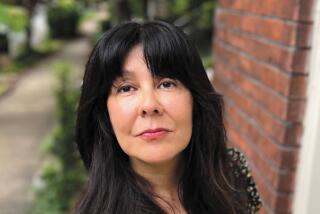In Celebration of Spirituality and Simplicity
Outside her West Hollywood hotel window, Kathleen Norris, author of the surprise 1993 bestseller “Dakota: A Spiritual Geography,” can see a Sunset Boulevard billboard. It pictures a fashion model in a lime-colored miniskirt and revealing, gauzy lime top.
Norris is wearing a less eventful, wine-colored dress and scarf. In understatement as flat as the Plains, she says: “All the trends catch on three to five years late in South Dakota. But I have the feeling that lime green won’t make it there.”
With one exception: Lime Jell-O has long been a staple of women’s club luncheons. And, as Norris has written, when you say “salad” in the western Dakotas, you may mean lime Jell-O with Cool Whip and sliced bananas.
“It’s like interplanetary travel to come here from there,” says Norris, a resident of Lemmon, S.D., and in Los Angeles recently to promote her new book, “The Cloister Walk” (Riverhead Books), about her time living with Benedictine monks and nuns.
Yet to her astonishment, connections exist between the Dakotas and elsewhere: like the Los Angeles minister who wrote to Norris to say that, after reading “Dakota” (Houghton Mifflin), he better understood the older members of his congregation. Of Germanic and Russian descent, they had fled the Dakotas decades ago and rarely discussed the harsh Plains life they left behind. Says Norris: “I never envisioned that someone like him could have found use for my book.”
“The Cloister Walk” may also offer surprising connections for urban and rural dweller alike, particularly baby boomers who, like Norris, 48, rejected organized religion years ago yet hunger for simplicity and spirituality in this age of downsizing, franchising and corporate merging.
Child psychiatrist and author Dr. Robert Coles, in the New York Times Book Review, glowingly compared Norris to writers James Agee and William Carlos Williams. Wrote Coles: “Her writing is personal and epigrammatic--a series of short takes that ironically addresses the biggest subject matter possible: how one ought to live a life, with what purposes in mind.”
A blend of essays and journal entries, “The Cloister Walk,” published last month, records how Norris, a fallen-away Protestant and married, immersed herself among Catholicism’s Benedictines. In the process she returned to the Protestantism of her youth and became a lay preacher at two Presbyterian churches. And she became a Benedictine oblate, or associate, taking an abbreviated version of their vows.
She has no desire, however, to convert to Catholicism. “When I’m in Lemmon, I’m Presbyterian. But I become this weird Benedictine wanderer when I’m not there. I’m a poet. I can live with my contradictions,” says Norris, who can be brusque one moment, playful the next.
The 384-page book is structured around her two, nine-month residencies at St. John’s Abbey in Minnesota, home to about 200 Benedictines, and other visits with Benedictines from 1991 to 1994. The book shuttles between her timeless time in contemplative atmospheres and sojourns in Lemmon, Manhattan, Los Angeles and Honolulu.
Norris muses with intensity on virgin martyrs of centuries ago and Vogue models, celibacy and consumerism, sexuality and sexual abuse by priests, American marriage and her own married life. With poetic and feminist sensibilities, she expands on themes she explored in “Dakota.”
She links the disparate worlds of 4th century desert monks and modern-day Benedictines to epiphanies in the South Dakota town where she and her husband, poet David Dwyer, moved to from New York City in 1974.
They moved there to settle her grandmother’s estate, planning to stay a year or so in the white-frame, two-bedroom house where her grandparents had lived. But Norris and Dwyer never left, writing and working odd jobs to make ends meet--he tending bar, translating French books; she keeping books for a cable company, teaching poetry in the schools, working in the library.
“I’ve always considered myself a literary writer,” says Norris, educated at Bennington College and the author of three poetry books. Her narrative and lyrical poems have appeared in the New Yorker and the Paris Review. In her new book, she says, “I’m writing for a general audience, for people with little or no interest in religion or monastic studies.”
That described her until 1983 when she “stumbled across the Benedictines” after going to a reading at a North Dakota abbey 90 miles from her town. Later, teaching poetry in a school for Native Americans, her hosts lodged her with Benedictine nuns.
There, she discovered the rules set down in the 6th century by St. Benedict. She found down-to-earth advice on living in a community--a subject that has intrigued her since moving to Lemmon with its dwindling population, now at 1,600 residents.
The Benedictines, she told a book-signing audience at Dutton’s in Brentwood, provide a model for people in Los Angeles or Lemmon. Benedictines, found in 100 communities throughout the country, including Valyermo in the San Gabriel Mountains, follow two key tenets: Commit to one place and commit to change.
*
How Benedictines, who eat family-style, have managed that for 1,500 years, Norris says, offers lessons to Americans obsessed with mobility and individualism. She asks, “Do we eat from a common bowl or do we want to eat from a prepackaged TV dinner, which we eat alone? Do we have any common life left in this culture or is it all based on individuals?”
She writes: “In a world in which we are so easily labeled and polarized by our differences: man / woman, Protestant / Catholic, gay / straight, feminist / chauvinist, monastic hospitality is a model of the kind of openness we need if we are going to see and hear each other at all.”
Lest she become a preachy Christian, she says, her editor, who is Jewish, had to pull her back more than once. Indeed, the book is filled with ordinary life, tales from the wine cellar, frank talk about love affairs and monk jokes.
The Benedictines themselves, she says, were not judgmental--which is how she viewed religion for 20 years after she stopped going to church. “Like so many, I am put off by religious language as it’s manipulated by television evangelists,” she writes. When she first encountered Benedictines, she says she thought she “might get preached at. But the Benedictines were hospitable, not in an oppressive way.”
In the end, through Benedictine liturgy she rediscovered rich metaphors of her Methodist church choir days in Washington, D.C., Illinois and Hawaii. She found it energizing to read anew psalms in which “rivers clap their hands, hills dance like yearling sheep.”
*
Until her success with “Dakota,” she labored in obscurity for 20 years, not even getting grants as her husband did from the National Endowment for the Arts. Now, she says, “my husband and I have a middle-class income.”
One reviewer complained that Norris’ husband appears as a shadowy figure: He’s in the South Seas. Or smoking a cigarette outside an abbey. Or a policeman’s finding him, saying: “I never saw a man so depressed.”
Norris, who negotiated with her husband about how he would appear in print, says: “He’s a private person.” Raised Catholic, he, however, lacks Norris’ enthusiasm for religion. She says, “We’re just two crazy writers living in a dusty little house in a dusty little town on the Plains.”
Writing about how she sought solace in the Song of Songs when her husband was depressed, she says: “True intimacy is frightening, and I was well into my marriage before I realized that I either had to seek it or live a lie.”
Once, after Dwyer was missing for three days, Norris found him in a Benedictine-run hospital. “Depression had turned him inside out.” He looked “as ravaged as the corpus on the crucifix on the wall behind him.”
But she writes of lighter moments too, such as the Easter morning when a cowboy friend awoke Norris and Dwyer, who have no children. To their surprise he was standing over their bed with a bottle of whiskey and a bucket of fresh-cut Rocky Mountain oysters.
Soon, Norris, Dwyer and cowboy were making a whiskey toast and eating Norris’ homemade bread while Dwyer, known locally as a great cook, stir-fried the gonads from a yearling bull--all in celebration of the holy day.
More to Read
Sign up for our Book Club newsletter
Get the latest news, events and more from the Los Angeles Times Book Club, and help us get L.A. reading and talking.
You may occasionally receive promotional content from the Los Angeles Times.









